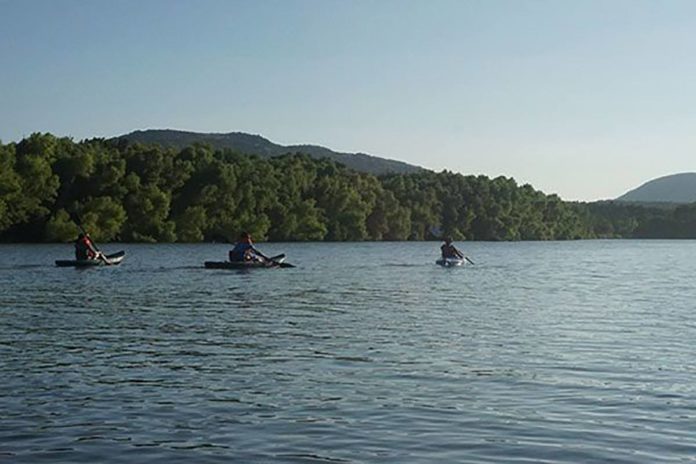By Cathy Dunton, Class of 2018
The drive west took 14 hours, and the scenery changed gradually from tall trees and urban structures to idyllic farmlands. Each moment reminded me of how far I was away from home and how unique this rotation will be. I have been interested in completing a rotation at an Indian Health Service (IHS) site since it was introduced to me at my first pharmacy school interview. When given the chance to select an IHS site as one of my rotations, I jumped at the opportunity. My five-week APPE rotation at Lawton Indian Hospital (LIH) ambulatory care clinics provided me with the opportunity to practice providing direct patient care under the guidance of my preceptor, Lieutenant Commander Jessica Steinert, PharmD, of the United State Public Health Service Commissioned Corps. Under her guidance, I also learned a great deal about the U.S. Public Health Service and how IHS serves its target population.
Lawton, Okla., is about an hour and a half southwest of Oklahoma City. LIH is located on federal land and serves a diverse population of Native American tribes. The outpatient pharmacy dispenses an average of 1,100-1,800 prescriptions per day, serving both the immediate community in the outpatient pharmacy and mail order prescriptions. The pharmacy also has four pharmacist-run clinics and participates in many hospital-wide initiatives. In the tobacco cessation clinic, I practiced motivational interviewing and active listening as I helped patients with coping strategies and medications to encourage them to quit smoking. In the anticoagulation clinic, patients came in for weekly, biweekly or monthly visits to help monitor their international normalized ration (INR), possible side effects and lifestyle modifications. I was able to help manage their warfarin doses and provide education on a myriad of factors that may affect warfarin effectiveness and INR levels.
LIH also has a Hepatitis C clinic, established in 2015 by Dr. Steinert as part of Oklahoma’s Hepatitis C CURE Project for which she is a CURE unit coordinator. This project allows her to network with other federal IHS Hepatitis C clinics within Oklahoma and established a platform for standardized care, as well as share reporting for outcomes. Prior to 2015, there was just one Hepatitis C clinic in federal Oklahoma IHS sites, and today this project has expanded treatment across the state. In 2017 LCDR Steinert received a National IHS Director’s Award for successfully establishing the Hepatitis C clinic at LIH. To this day, the clinic has had a 100 percent cure rate for all compliant patients.
Pharmacist-run clinics are still growing at LIH. Another staff pharmacist established the adult asthma clinic that provides counseling and education for inhaler use. Partnering with the respiratory therapists, the clinic also sees all patients with newly diagnosed asthma with a pulmonary function test referral to control symptoms.
Outside of the clinics, I was invited to attend and participate in initiatives as part of a multi-disciplinary team in the hospital. I attended bimonthly antimicrobial stewardship meetings where primary care providers, pharmacists and hospital administrators discussed antibiotic prescribing practices and other ways LIH can further incorporate Centers for Disease Control and Prevention recommendations into its antimicrobial stewardship practices. I also presented some outpatient clinic strategies that have shown evidence of reducing unnecessary antibiotic prescribing.
The other major initiative that I participated in was combatting the opioid crisis. The local Heroin Opioid Pain Efforts (HOPE) committee mirrors the national-level IHS HOPE committee and holds meetings with a multi-disciplinary team of administrators, clinicians, pharmacists and behavioral health and nursing staff. They implemented strategies for reducing opioid overprescribing and preventing opioid abuse and overdose. As part of an effort to start a naloxone clinic in the pharmacy, I helped perform chart reviews to examine pain medication prescribing practices. It was my first experience seeing opioid overuse, and it expanded my understanding of the complexity of the opioid crisis.
Beyond my time in the pharmacy, I took full advantage of all that Oklahoma has to offer. My weekends were comprised of attending local events and outdoor activities with the pharmacy staff. In the short few weeks in Lawton, I attended my first rodeo, and a couple weeks later, I attended the annual American Indian Exposition 45 minutes away in Anadarko. My favorite time here was spent outdoors. Just 20 minutes west of the hospital is the Wichita Mountains Wildlife Refuge, where I hiked and kayaked with Dr. Steinert and other pharmacy staff. From the summit of Mount Scott in the refuge, I had full view of the beautiful prairie terrain beyond a smattering of towns and windmills. The unexpected natural beauty of the place took my breath away.
I am thrilled to have ventured out of my comfort zone to experience this unique ambulatory care rotation. I encourage anyone who wants to explore the breadth of a career in pharmacy to complete a rotation at an IHS site. The skills learned, the sights seen and the experiences felt here at LIH will shape me as I advance my education and career. I am grateful for the opportunity to gain insight into this aspect of pharmacy and public health, and I encourage anyone to seek their own adventures at any of the IHS sites for their rotations.










